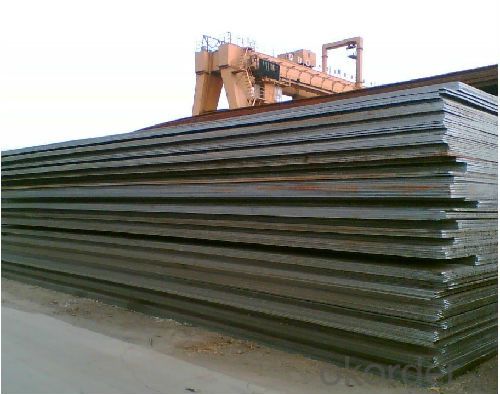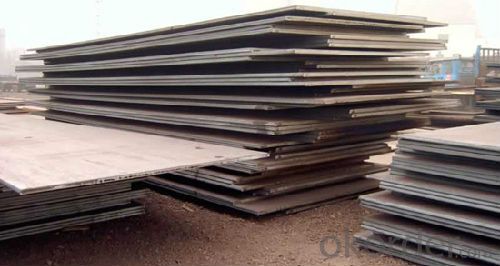Carbon Steel Plate China Structural Steel Plate High Quality Good Price
- Loading Port:
- Shanghai
- Payment Terms:
- TT or LC
- Min Order Qty:
- 1000 m.t.
- Supply Capability:
- 60000 m.t./month
OKorder Service Pledge
OKorder Financial Service
You Might Also Like
Product Description:
OKorder is offering Carbon Steel Plate China Structural Steel Plate High Quality Good Price at great prices with worldwide shipping. Our supplier is a world-class manufacturer of steel, with our products utilized the world over. OKorder annually supplies products to European, North American and Asian markets. We provide quotations within 24 hours of receiving an inquiry and guarantee competitive prices.
Product Applications:
Carbon Steel Plate China Structural Steel Plate High Quality Good Price are ideal for structural applications and are widely used in the construction of buildings and bridges, and the manufacturing, petrochemical, and transportation industries.
Product Advantages:
OKorder's Carbon Steel Plate China Structural Steel Plate High Quality Good Price are durable, strong, and resist corrosion.
Main Product Features:
· Premium quality
· Prompt delivery & seaworthy packing (30 days after receiving deposit)
· Corrosion resistance
· Can be recycled and reused
· Mill test certification
· Professional Service
· Competitive pricing
Product Specifications:
Introduction
Ordinary carbon structural steel and ordinary carbon steel. The carboncontent of less than 0.25% 0.06-0.22%, the most commonly used. Belongs to the low carbon steel, in each metal steel grades, minimum yield point thickness is less than 16mm. Compared with high-quality carbon structural steel, carbon content, performance and phosphorus, sulfur and other residual element content range. Provide security conditions in the China and some countries,ordinary carbon steel is divided into three categories: Steel (Xing Gang), only to ensure that the mechanical properties, does not guarantee the chemical composition, type B steel (B steel), only to ensure that the chemical composition, does not guarantee the special mechanical properties; steel(steel). Not only guarantee the chemical composition and mechanical properties, guarantee. Manufacturing structural components often used in special steel is very important..
Component is mainly used for the production of carbon structure steel structure engineering. It is commonly used to supply conditions, high sulfur,phosphorus content in steel, allows up to 0.050% and 0.045% respectively.Steel accounted for a larger proportion, total output in this steel.
3 application of this kind of steel from oxygen converter, open hearth furnaceor electric furnacesmelting, hot rolled steel, steel strip, the general part and bar. Plate usually volume (including control rolling) or normalizing treatment delivery. The chemical composition of the steel, mechanical properties, andbendingperformance shall comply with the relevant provisions.
In the Chinese national standard GB700-88 steel according to yield values are divided into 5 grades, and by mass is divided into 4 level. With the letter Qsymbol level, yield, yield value, quality rating symbol, consisting of 4 parts of the deoxidation method according to the order of.
The scope of application of this kind of steel is very extensive, mainly used for welding, riveting or steel structural bolts, minority is producing all kinds of machinery parts. Q195, and low strength of Q215 steel, the production of low carbon steel wire. Stainless steel wire mesh, the roof plate, welded steel pipe,anchor bolts and rivets etc.. Q235 steel of moderate intensity, and has good plasticity and toughness, easy forming and welding. This steel usually used for reinforcing steel structure, also used as a rivet, a railroad spike and variousmechanical parts, such as bolts, connecting rod, connecting rod. 255, Q275 high strength steel used in agricultural machinery production, can also be used as reinforcement of railway fishplate.
According to the special requirements for steel performance in some industries, for ordinary carbon structural steel composition adjustment and a series of professional steel after forming, such as cold heading steel, bridge steel, pressure vessel steel, steel, steel for boiler. In addition to the chemical composition of the strict control of steel used, so that the performance of the conventional, but also provides some special inspection of the project, such as low temperature impact toughness, aging sensitivity, gas in steel, inclusions and fracture etc..
Overview of Q235A features and scope of applications: Q235A toughness and the plasticity is good, have certain elongation, has good welding properties and hot workability. Q235A is generally used in hot rolling state, with steel, the rolling steel, steel plate, steel pipe can be used for welded structures, bridges and generally not important machine parts manufacturing all kinds of, such as bolts, rivets, rings and connecting rod, etc..
Said method: the symbolic quality rating symbol + deoxidation method of Q+ digital + composition. Its steel dubbed "Q", representing the yield point of steel, behind the figures to show that the yield point value units are MPa Q235 says such yield point (s) of carbon structural steel, 235 MPa. The necessary grades can be followed Mark said quality grade and deoxidizing method symbol. Quality level symbols are for A, B, C, D. Deoxidation method symbol: F said rimming steel;
B said semi killed steel: Z said calm steel; TZ said special calm steel, steel standard symbols not calm, namely Z and TZ are not standard. For example, Q235-AF said a rimmed steel. Carbon steel specially uses, such as for bridge steel.
FAQ:
Q1: Why buy Materials & Equipment from OKorder.com?
A1: All products offered byOKorder.com are carefully selected from China's most reliable manufacturing enterprises. Through its ISO certifications, OKorder.com adheres to the highest standards and a commitment to supply chain safety and customer satisfaction.
Q2: How do we guarantee the quality of our products?
A2: We have established an advanced quality management system which conducts strict quality tests at every step, from raw materials to the final product. At the same time, we provide extensive follow-up service assurances as required.
Q3: How soon can we receive the product after purchase?
A3: Within three days of placing an order, we will begin production. The specific shipping date is dependent upon international and government factors, but is typically 7 to 10 workdays.
Q4: What makes stainless steel stainless?
A4: Stainless steel must contain at least 10.5 % chromium. It is this element that reacts with the oxygen in the air to form a complex chrome-oxide surface layer that is invisible but strong enough to prevent further oxygen from "staining" (rusting) the surface. Higher levels of chromium and the addition of other alloying elements such as nickel and molybdenum enhance this surface layer and improve the corrosion resistance of the stainless material.
Q5: Can stainless steel rust?
A5: Stainless does not "rust" as you think of regular steel rusting with a red oxide on the surface that flakes off. If you see red rust it is probably due to some iron particles that have contaminated the surface of the stainless steel and it is these iron particles that are rusting. Look at the source of the rusting and see if you can remove it from the surface.
Images:



- Q:Can steel sheets be used for electrical grounding?
- Yes, steel sheets can be used for electrical grounding. Steel is a good conductor of electricity and can effectively dissipate electrical charges into the ground, making it a suitable material for grounding applications.
- Q:How do steel sheets perform in terms of earthquake resistance?
- Steel sheets have excellent earthquake resistance due to their high strength and ductility. They can withstand the lateral forces and vibrations during an earthquake, minimizing damage and ensuring the structural integrity of buildings and structures.
- Q:Can steel sheets be used in energy applications?
- Yes, steel sheets can be used in energy applications. Steel is a versatile material that can withstand high temperatures, pressure, and corrosion, making it suitable for various energy-related applications such as power generation, transmission, and storage. Steel sheets can be used in the construction of power plants, pipelines, and energy storage systems, among other applications, due to their strength, durability, and ability to efficiently conduct heat and electricity.
- Q:Can the steel sheets be easily folded or creased?
- It is not possible to easily fold or crease steel sheets. Steel, being a robust and inflexible material, demands considerable force for bending or creasing. Its durability and resistance to deformation make it a popular choice in construction and manufacturing. Nevertheless, if the steel sheets are sufficiently thin, they might have enough malleability to be bent or creased by utilizing suitable tools and techniques.
- Q:What welding rod should be used for welding of cast iron and Q235B steel plate?
- Such as outdoor and field construction, should be relatively closed work environment, do a good job of wind work, reduce air flow. Two. Use acetylene torch to preheat the welding and its surrounding parts, and then weld them to a temperature. Three, welding side edge knocking release and eliminate stress. Four, slow cooling is correct, after welding torch with air flow slow heating, avoid welding temperature drop.
- Q:Can steel sheets be used for modular construction or prefabricated buildings?
- Yes, steel sheets can be used for modular construction or prefabricated buildings. Steel sheets offer high strength and durability, making them suitable for constructing modular or prefabricated buildings. They can be easily fabricated, assembled, and disassembled, allowing for efficient construction processes. Additionally, steel sheets provide excellent resistance to fire, pests, and extreme weather conditions, making them a popular choice for modular construction or prefabricated buildings.
- Q:Are the steel sheets suitable for automotive body repairs?
- Yes, steel sheets are commonly used in automotive body repairs due to their durability and strength, making them suitable for repairing damaged car bodies.
- Q:Is the steel plate 1.5 meters wide and 2 meters wide at the same price? .
- The price of the steel plate is calculated by ton. There are many ways to calculate the price. The whole plate is a kind of price. If you need a specific size, if the cutting angle can not be used, it will be calculated accordingly.
- Q:What is the weight of a typical steel sheet?
- The weight of a typical steel sheet can vary depending on its dimensions and thickness. However, on average, a standard steel sheet can weigh anywhere from 15 to 30 pounds per square foot.
- Q:How do steel sheets compare to other types of sheet materials?
- Steel sheets have several advantages over other types of sheet materials. First, they are extremely strong and durable, making them suitable for a wide range of applications. They are also highly resistant to corrosion, which is especially beneficial in harsh environments. Additionally, steel sheets offer excellent heat and fire resistance, making them a safe choice for many industries. Furthermore, steel sheets are versatile and can be easily fabricated into various shapes and sizes. However, steel sheets can be heavier and more expensive compared to other materials, and they may require additional protective coatings to prevent rusting. Overall, steel sheets are a reliable and versatile option that offers exceptional strength, durability, and resistance.
1. Manufacturer Overview |
|
|---|---|
| Location | |
| Year Established | |
| Annual Output Value | |
| Main Markets | |
| Company Certifications | |
2. Manufacturer Certificates |
|
|---|---|
| a) Certification Name | |
| Range | |
| Reference | |
| Validity Period | |
3. Manufacturer Capability |
|
|---|---|
| a)Trade Capacity | |
| Nearest Port | |
| Export Percentage | |
| No.of Employees in Trade Department | |
| Language Spoken: | |
| b)Factory Information | |
| Factory Size: | |
| No. of Production Lines | |
| Contract Manufacturing | |
| Product Price Range | |
Send your message to us
Carbon Steel Plate China Structural Steel Plate High Quality Good Price
- Loading Port:
- Shanghai
- Payment Terms:
- TT or LC
- Min Order Qty:
- 1000 m.t.
- Supply Capability:
- 60000 m.t./month
OKorder Service Pledge
OKorder Financial Service
Similar products
New products
Hot products
Related keywords






























